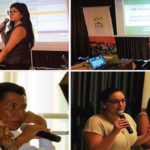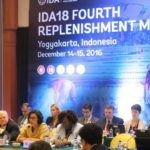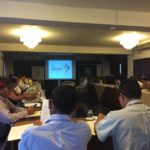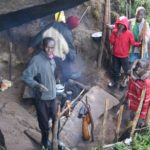This post is also available in: Spanish

Forests are essential to the livelihoods of 90 percent of the 1.2 billion people living in extreme poverty, and forests indirectly support the natural environments that nourish agriculture and food supplies for nearly half the population of the developing world.
A high percentage of the world’s impoverished people source food, medicine, building materials and fuelwood directly from forests, and depend on the forest ecosystem services of water provision and purification, flood prevention, and climate change adaptation. The importance of the rainforests is immense, given that they are home to approximately half the plants and animals living on Earth, vast amounts of the world’s freshwater, and regulate temperatures and weather patterns across the globe. Protecting forests is also one of the most cost effective climate change mitigation solutions and must be at the top of the international agenda in efforts to fight climate change.
BIC’s current work includes a range of advocacy and research activities surrounding the protection of forests and the rights of forest dependent peoples in the context of international development, particularly the international financial institutions (IFIs). In the context of the World Bank, forest protection and forest peoples’ rights play a key part in achieving the Bank’s twin goals of ending extreme poverty and boosting shared prosperity. BIC’s current work on forests includes the following lines of work:
- BIC is following the implementation of the Forest Action Plan, which defines how the Bank’s will engage in the forest sector, and sectors impacting forests between FY 2016 and 2020.
- As the World Bank develops its in country strategies, BIC works with civil society to ensure genuine and effective participation, and to strengthen messages around forest protection and forest peoples’ rights.
- BIC is working to influence the World Bank’s IDA replenishment cycles, pushing for forest related recognition and commitments, including follow up on the IDA18 commitments for the World Bank to produce Forest Notes for at least 10 IDA countries.
- Within the World Bank’s environmental and social safeguard policies, BIC promotes strengthening the World Bank’s environmental and social standard addressing natural environments. BIC is also calling for a review of the safeguards for Development Policy Financing.
Updates
 A call for the World Bank to prioritize forests and forest people’s rights in the context of climate change
A call for the World Bank to prioritize forests and forest people’s rights in the context of climate changeThis post is also available in: SpanishLast week world leaders met in Bonn to co...
 Country Partnership Frameworks – Influencing World Bank Investments ‘Upstream’
Country Partnership Frameworks – Influencing World Bank Investments ‘Upstream’This post is also available in: SpanishWorld Bank projects and policies affect t...
 IDA18 in a Changing World
IDA18 in a Changing WorldThis post is also available in: Spanish After several months of negotiatio...
 “Un Bosque de Dinero” now in English!
“Un Bosque de Dinero” now in English!This post is also available in: Spanish A Forest of Money? – PDF Today, BI...
 BIC Rebuttal to the World Bank’s Response to BIC’s case studies on Development Policy Operations in Peru, Egypt, Mozambique, and Indonesia
BIC Rebuttal to the World Bank’s Response to BIC’s case studies on Development Policy Operations in Peru, Egypt, Mozambique, and IndonesiaThis post is also available in: SpanishBIC Rebuttal to the World Bank’s Response...
 Workshop on Peru World Bank Country Partnership Framework co-organized by BIC, DAR and AIDESEP “Reformas Globales y Alcances Nacionales”
Workshop on Peru World Bank Country Partnership Framework co-organized by BIC, DAR and AIDESEP “Reformas Globales y Alcances Nacionales”This post is also available in: SpanishLima, Peru. January 24, 2017 Summary On J...
 World Bank introducing new fossil fuel subsidies, undermining its own climate change commitments and forest protection efforts
World Bank introducing new fossil fuel subsidies, undermining its own climate change commitments and forest protection effortsThis post is also available in: Spanish Clearing for a coal mine, Central Kalima...
 Update: World Bank Should Release Draft of Country Partnership Framework for Meaningful Consultation
Update: World Bank Should Release Draft of Country Partnership Framework for Meaningful ConsultationThis post is also available in: Spanish January 11, 2017 The World Bank is in th...
 New report reveals the World Bank’s murky financial entanglements with India’s most irresponsible corporations
New report reveals the World Bank’s murky financial entanglements with India’s most irresponsible corporationsThis post is also available in: SpanishThe World Bank Group is covertly funding...
 Alert: Eviction order issued to the Sengwer people to leave their ancestral land – with just 7 days notice
Alert: Eviction order issued to the Sengwer people to leave their ancestral land – with just 7 days noticeThis post is also available in: Spanish Despite promises from World Bank Preside...
Timeline
A brief history of the evolution of the World Bank’s forest strategies and operational policies from the 1990s to the present. The timeline includes significant Inspection Panel cases related to the Bank’s Environmental Assessment, Forests, and Natural Habitats Policies and the Bank’s current review and update of its safeguard policies.
REDD+
Therefore, emissions from deforestation and forest degradation must be reduced, or they may undercut reductions in energy-related and industrial greenhouse gas emissions and undermine efforts to solve climate change.
The 1997 the Kyoto Protocol on greenhouse gas emissions excluded policies related to deforestation and degradation. The rise in deforestation, particularly in Brazil, after that exclusion resulted in the formation of the Coalition for Rainforest Nations. Participant nations included Papua New Guinea, Costa Rica, and other nations with large tropical forests.
The Coalition for Rainforest Nations initiated for the first time in 2005 a request to consider “reducing emissions from deforestation in developing countries,” at the 11th Conference of the Parties (COP-11) of the United Nations Framework Convention on Climate Change (UNFCCC). In 2007, during the 13th Conference of the Parties (COP-13) of the UNFCCC in Bali, an agreement was reached on “the urgent need to take further meaningful action to reduce emissions from deforestation and forest degradation,” launching the REDD mechanism. The principles for an international REDD framework were put forward during the 15th Conference of the Parties to the UNFCCC (COP-15), which was held in Copenhagen in December 2009.
While civil society groups support the concept of conservation with the intention of reversing climate change and protecting biodiversity, the reality is that with each of these forest finance mechanisms come grave dangers in implementation. It is crucial that civil society organizations actively monitor and critique forest protections in order to ensure that it is successful, or at least, that it is not harmful.
What are REDD, FIP, and FCPF?
A series of multilateral forest finance mechanisms have been created in order to funnel money into REDD initiatives across the globe. These mechanisms are:
- Forest Carbon Partnership Facility (World Bank)
- Forest Investment Program (World Bank)
- UN-REDD Programme
- REDD+ Partnership
The Forest Carbon Partnership Facility (FCPF) and the Forest Investment Program (FIP) were both created by the World Bank as pilot programs to help countries prepare for REDD (in the case of the FCPF) and to provide strategic and transformative investments in the forest sector (in the case of the FIP). BIC works to ensure sound environmental and social due diligence in these programs, as well as meaningful participation of forest-dependent communities in Africa, Asia, and Latin America on national REDD proposals.
BIC has also served as an official NGO observer to the FCPF, and closely coordinates efforts with the NGO and indigenous peoples’ observers of both the UN-REDD Programme (a United Nations-run program with similar aims to FCPF) and the FIP.
Civil Society Concerns about REDD
Loss of Livelihoods: A corollary concern is that governments may try to restrict traditional subsistence activities in the name of forest conservation, such as swidden agriculture, harvesting of timber and non-timber forest products for personal use, or restrict access for forest dependent peoples who hunt and fish in forest areas for survival. Rather than target the new drivers of deforestation, governments may find it easier to target politically marginalized populations.
Transparency: A general process concern is that mechanisms to support REDD readiness be transparent and open to the public, as significant public debate about the issues and the definition of national strategies is a prerequisite for reaching broad consensus on the ways forward. With respect to the FCPF, although the presence of observers at the meetings is a step forward, many of the documents submitted by countries have not been made available to the public in a timely manner, undercutting civil society’s role.
Participation: Another general concern is that national REDD strategies will be developed without significant input from civil society and forest dependent communities. It is feared that without ongoing and meaningful participation by all important stakeholders and rights holders, many of the potentially negative impacts of poorly designed REDD strategies will come to pass.
Use of Carbon Offsets and Carbon Trading of Forests: Many NGOs and indigenous organizations are highly critical of the idea of including forests in international carbon trading schemes. The idea of relying on markets to solve a market failure seems unwise, especially at a time when the world is reeling from the impacts of the economic crisis caused by these same markets engaged in highly complex and opaque trading that was poorly regulated. Some analysis suggests that forest offsets could flood the carbon market, lowering carbon prices below what would be needed to create significant changes, or even collapsing the market as a whole.
Some concerns center around trading REDD credits and stem from a number of different rationales, but center around the contention that offsets are unjust, ineffective at reducing greenhouse gas (GHG) emissions and could lead to perverse incentives. Allowing corporations in the industrialized countries to purchase offsets, especially potentially low-cost forest offsets, which they can then count towards their own GHG pollution cap, is inherently unjust and ineffective, because it moves responsibility for reducing GHGs from the North (countries that are historically responsible for global warming) to the South, and may allow industry in the North to postpone making the hard decisions and costly investments needed to reduce the GHG emissions of their industries. Carbon trading may also cause “regulatory chill” in the South as countries postpone legally mandating actions to reduce deforestation and risk becoming ineligible for REDD credits, which would no longer be “additional” under current Clean Development Mechanism (CDM) rules.
A further concern is that forest communities will be the losers in carbon deals which give increasing control to carbon trading companies, intermediaries and middlemen in charge of verification and monitoring to the detriment of local actors. Turning forests, and forest carbon, into a tradable commodity also violates the cultural and religious views of many of the world’s indigenous peoples.
Perverse Incentives: REDD schemes that channel monetary payments to the wrong beneficiaries risk rewarding those actors responsible for deforestation, such as logging companies that make pledges to move to sustainable forest management; or those who are responsible for converting natural forests into palm oil plantations or cattle ranches. Creating payments to reduce deforestation, if not carefully regulated and monitored on the ground, could actually lead to the creation of more commercial plantations, which qualify as forests under Clean Development Mechanism (CDM) rules. The promise of REDD payments schemes could also lead countries to increase deforestation in the short term so as to raise the levels of their reference scenario and thus secure higher payments.
Losing the Multiple Value of Forest: Another general concern is that in the rush to manage forests as carbon sinks, the other important reasons for forest conservation, such as biodiversity conservation, watershed management, and the preservation of other ecosystem services will get forgotten or pushed to the back burner.
Benefit Sharing: The complexities of sharing benefits from REDD across a variety of actors who contribute to actions to reduce deforestation is a serious challenge that many countries with poor forest governance are particularly poorly situated to meet. Most countries do not have legislation defining who owns carbon rights to forests, and there is already evidence that governments are moving quickly to vest all rights in the state. Many communities and local NGOs do not trust the state to make just and transparent decisions about how to allocate benefits, and are thus skeptical about the REDD being a mechanism to benefit local communities who have conserved their forests.
Resources
Safeguards documents:
 Civil Society submission on ESS6 March 2015
Civil Society submission on ESS6 March 2015 Civil Society Statement on ESS6 July 2014
Civil Society Statement on ESS6 July 2014
FCPF and FIP:
Forest Defender: A Tool for Understanding your Rights by our partners Center for International Environmental Law (CIEL)
Contacts
Debbie Pierce
Forest Program Associate
+1 (202) 624-0624
dpierce*bankinformationcenter.org
Kate Geary
Forest Program Manager
kgeary*bankinformationcenter.org


 Infographic: Forests & IDA
Infographic: Forests & IDA
 Analysis Of World Bank Finance & Forests
Analysis Of World Bank Finance & Forests Analysis of IFC Finance & Forests
Analysis of IFC Finance & Forests




 Facilitating Indigenous Involvement in REDD+ in Costa Rica
Facilitating Indigenous Involvement in REDD+ in Costa Rica
